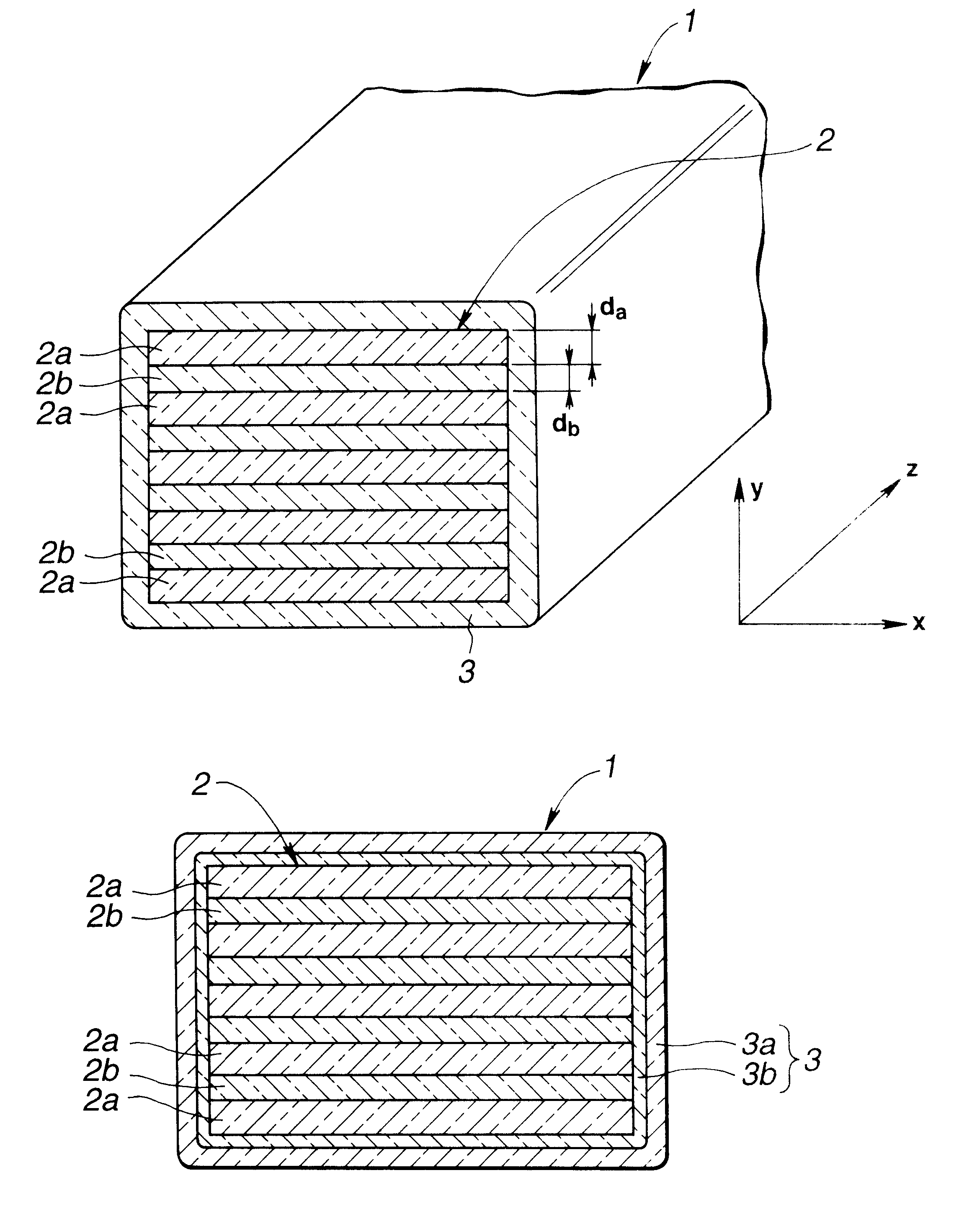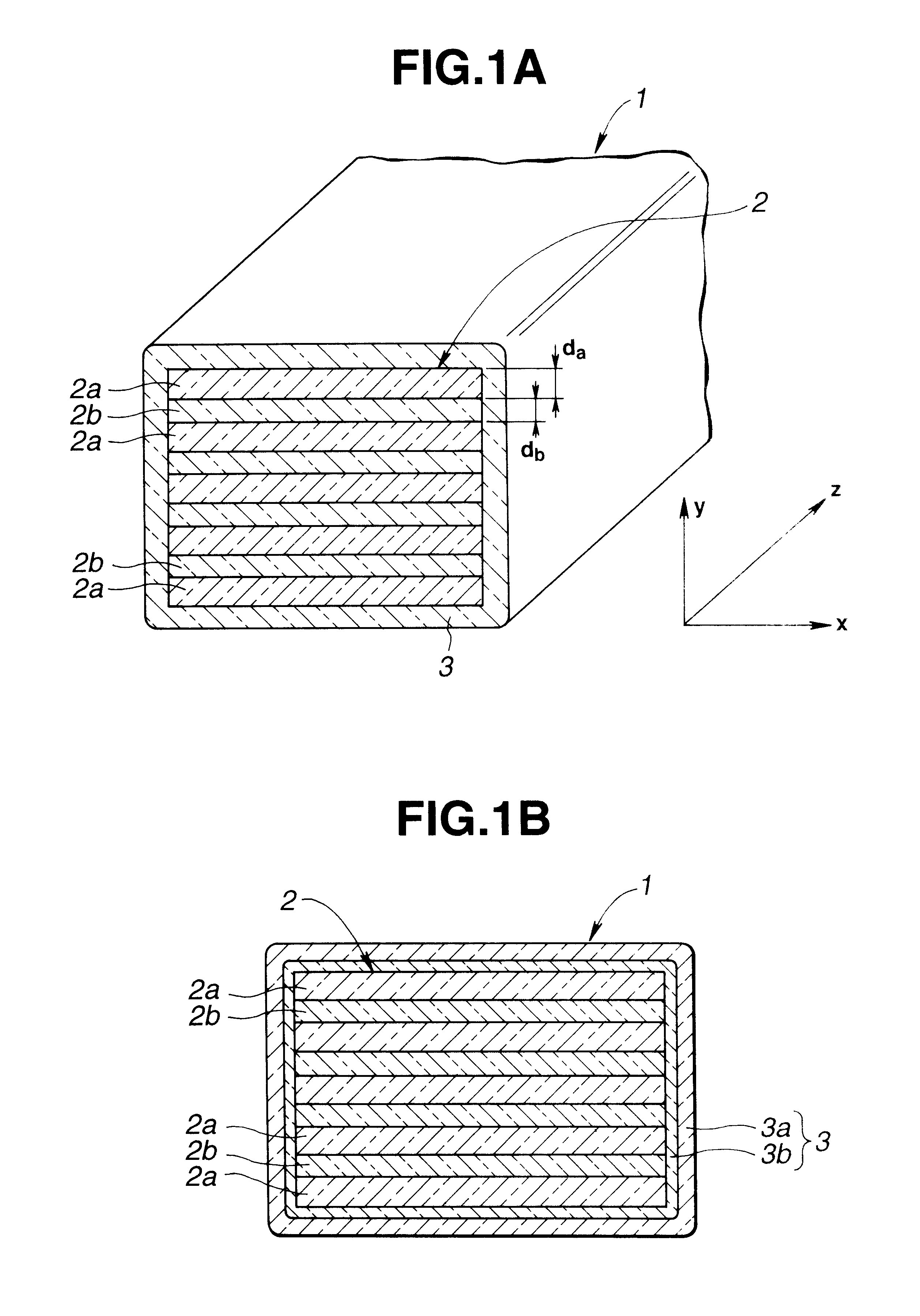Fibers with optical function
- Summary
- Abstract
- Description
- Claims
- Application Information
AI Technical Summary
Benefits of technology
Problems solved by technology
Method used
Image
Examples
examples 6-9
and comprative examples 2-3 will be described. In the examples 6-9, using Panlight AD-5503 manufactured by TEIJIN LTD. as PC as the polymer A with greater refractive index and Acripet MF (melt flow rate at 230.degree. C.=14) manufactured by Mitsubishi Rayon Co., Ltd. as PMMA as the polymer B with smaller refractive index, composite spinning is carried out at a take-up speed of 1,500 m / min. to obtain the fibers including the core 43 and the clad 44 arranged therearound as shown in FIG. 10A. The number of laminations of PC and PMMA layers 41, 42 is 20. In the comparative examples 2-3, fibers including the core 43 only and no clad 44 are manufactured in the same way. Those fibers are stretched by a roller stretching machine by 1.8 times to obtain stretched threads with 12 filaments. The section of each stretched thread is photographed by an electron microscope to measure the thicknesses of the PEC layer 41, the PMMA layer 42, and the clad 44 in the center of the section and a point the...
examples 10-11
and a comparative example 4 will be described. Using PET as the polymer A with greater refractive index and PMMA as the polymer B with smaller refractive index, composite spinning is carried out in substantially the same way as in the examples 1 and 6 to obtain the fiber as shown in FIG. 10A (example 10), the fiber as shown in FIG. 14A including the reinforcement 45 arranged in the core 43 and having substantially the same thickness as that of the clad 45 (example 11), and a fiber including the core 43 only and no clad 44 (comparative example 4). The tensile strength of the fibers is measured, the results of which are given in FIG. 15. FIG. 15 reveals that formation of the clad 44 contributes to a large improvement and further increase in tensile strength.
examples 12-16
will be described. Using PET as the polymer A with greater refractive index and PMMA as the polymer B with smaller refractive index, composite spinning is carried out in substantially the same way as in the examples 1 and 6 to obtain the fiber as shown in FIG. 10A. With the same structure of the core 43, the thickness of the clad 44 of PET is determined differently in the exmaples: 1.0 .mu.m in the example 12, 2.0 .mu.m in the example 13, 4.0 .mu.m in the example 14, and 6.0 .mu.m in the example 15. The tensile strength of the fibers is measured, the results of which are given in FIG. 16. FIG. 16 reveals that the fiber with the clad 44 in the examples is greater in tensile strength than the fiber with no clad 44 in the comparative example 4 (see a in FIG. 15), that with the thickness of the clad 44 more than 1.0 .mu.m, the tensile strength is greater than 1.0 g / d to show a practical value, and that as the thickness of the clad 44 increases, the tensile strength of the fiber also inc...
PUM
| Property | Measurement | Unit |
|---|---|---|
| Fraction | aaaaa | aaaaa |
| Length | aaaaa | aaaaa |
| Thickness | aaaaa | aaaaa |
Abstract
Description
Claims
Application Information
 Login to View More
Login to View More - R&D
- Intellectual Property
- Life Sciences
- Materials
- Tech Scout
- Unparalleled Data Quality
- Higher Quality Content
- 60% Fewer Hallucinations
Browse by: Latest US Patents, China's latest patents, Technical Efficacy Thesaurus, Application Domain, Technology Topic, Popular Technical Reports.
© 2025 PatSnap. All rights reserved.Legal|Privacy policy|Modern Slavery Act Transparency Statement|Sitemap|About US| Contact US: help@patsnap.com



